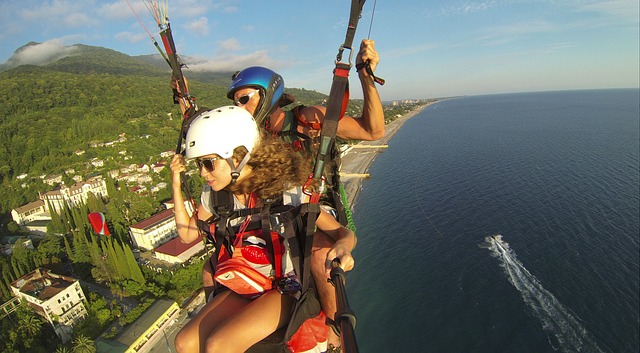If you’ve stumbled upon this article, you must be wondering whether you can still indulge in your passion for paragliding during pregnancy. First of all, congratulations on your exciting journey into motherhood! As an avid paraglider myself, I completely understand your desire to stay active and enjoy the adrenaline rush. However, safety should always come first, especially when you have a precious little one growing inside you.
The answer to whether you can paraglide while pregnant is that it depends on your individual circumstances and should be discussed with your healthcare professional. Pregnancy brings physical changes, and paragliding involves inherent risks. Consulting with your healthcare provider is crucial to assess whether paragliding is safe for you during pregnancy.
In this comprehensive guide, I’ll delve into the topic of paragliding and pregnancy to help you make an informed decision. While paragliding can be an exhilarating experience, it also poses certain risks that need careful consideration. I’ll cover everything you need to know to ensure your well-being and that of your baby.
Before I go any further, let’s establish one crucial point: consulting with your healthcare professional is an absolute must. Every pregnancy is unique, and getting personalized advice is essential to understanding whether paragliding is a safe option for you.
Now, let’s take flight into the details of paragliding and pregnancy, so you can make an educated choice that suits your needs and keeps both you and your baby happy and healthy.
Understanding Paragliding and Its Risks
Before I delve into the topic of paragliding during pregnancy, let’s first understand what paragliding is and why it captures the hearts of adventure enthusiasts worldwide.
Paragliding is an exhilarating recreational sport that involves flying through the air with a specially designed parachute-like wing. Unlike traditional parachutes used for skydiving, paragliders are inflatable and allow for longer, more controlled flights. The pilot is harnessed to the glider and uses the wind’s force to glide, soar, and even navigate through the air.
The feeling of freedom and being one with nature is what draws many individuals to paragliding. It offers a unique perspective of the world below, allowing you to experience the beauty of landscapes from a bird’s-eye view. It’s no wonder why so many adventure seekers find paragliding to be an unforgettable and addictive activity.
However, like any adventure sport, paragliding comes with its inherent risks. These risks can include:
- Injury during takeoff or landing: Paragliders need to launch and land on their feet, which can be physically demanding and may lead to accidents if not executed properly.
- Collisions and mid-air incidents: Sharing airspace with other paragliders or aircraft can potentially lead to collisions or near misses, making awareness and communication crucial.
- Changing weather conditions: Wind patterns and weather can change rapidly, affecting flight dynamics and possibly posing challenges to the pilot’s control.
- Equipment failure: Although modern paragliders are designed with safety in mind, equipment failure is a possibility that should be considered.
- Turbulence and thermals: Air currents can create turbulence and thermals, which may challenge the pilot’s flying skills.
Given these inherent risks, it’s essential to approach paragliding with a safety-first mindset. Now, let’s address the central question: Can you paraglide while pregnant?
Consulting with Healthcare Professionals
When it comes to considering paragliding or any adventure sport during pregnancy, the most critical step is consulting with your healthcare professional. Every pregnancy is unique, and your medical history, current health, and any potential risk factors must be carefully evaluated before engaging in any physically demanding activity.
Here’s why seeking professional medical advice is crucial:
- Personalized Assessment: Your healthcare provider understands your medical history, pre-existing conditions, and any potential risks associated with your pregnancy. They can assess whether paragliding aligns with your individual situation.
- Safety of Mother and Baby: Your healthcare professional’s primary concern is ensuring your safety and that of your baby. They can guide you on whether paragliding could pose any risks during the different stages of pregnancy.
- Understanding Physical Limitations: Pregnancy can bring about various physical changes in your body, affecting your balance, stamina, and overall fitness. Your healthcare provider can help you understand these limitations and how they might impact paragliding.
- Potential Complications: Pregnancy can be unpredictable, and certain complications may arise that could affect your ability to engage in physically demanding activities like paragliding. Your healthcare provider can educate you about the warning signs and when it’s best to avoid such activities.
- Expert Advice on Timing: Depending on the stage of your pregnancy, your doctor can recommend the safest time (if any) to participate in paragliding. Early and late stages of pregnancy may carry different risks and considerations.
During your consultation, make sure to be open and honest about your passion for paragliding. Share details about your experience level, the intensity of your flights, and any specific concerns you may have. This information will enable your healthcare professional to provide more tailored advice.
Keep in mind that the decision to paraglide during pregnancy may not be solely up to your personal preferences. Your healthcare provider’s guidance should be respected and followed, as they have your best interests at heart.
Remember, being an expectant mother doesn’t mean giving up on your sense of adventure. There are plenty of safe and enjoyable activities that you can engage in during pregnancy. Let’s explore all the essential factors to consider and the safety guidelines for paragliding while pregnant so that you can make an informed choice for yourself and your little one.
Potential Risks of Paragliding During Pregnancy
As much as we love the thrill of paragliding, it’s essential to recognize that participating in this adventure sport during pregnancy carries potential risks. While every pregnancy is different, and some women may have safer experiences than others, it’s crucial to be aware of the general risks involved. Here are the key factors to consider:
- Physical Demands: Paragliding requires a certain level of physical fitness and stamina. During pregnancy, your body undergoes significant changes to support the growing baby, which may impact your ability to handle the physical demands of flying. The strain on your back, abdominal muscles, and pelvic region might be intensified during flight.
- Sudden Movements and Impact: Paragliding involves takeoff, landing, and maneuvers that may require sudden movements and impact on the body. As your pregnancy progresses, your balance and stability might be affected, increasing the risk of injury during these phases.
- Fetal Health Concerns: The developing fetus is sensitive to changes in blood pressure and oxygen levels. The reduced oxygen availability at higher altitudes might not be ideal for the baby’s growth and development, especially during more prolonged flights or at high elevations.
- Stress and Anxiety: Paragliding can be both exciting and nerve-wracking. Pregnancy is a time when emotional well-being is crucial for the health of both the mother and the baby. Extreme stress or anxiety during flight might not be beneficial for either of you.
- Weather Conditions: Weather plays a significant role in paragliding safety. Unpredictable wind patterns, turbulence, or sudden weather changes could pose risks during flight, even for experienced pilots. During pregnancy, it’s essential to be extra cautious about adverse weather conditions.
- Potential Accidents: While paragliding is generally considered a safe sport with proper training and equipment, accidents can happen due to equipment malfunctions, human error, or external factors. Pregnancy might influence how you react and respond to such situations.
- Medical Facilities and Accessibility: Depending on the location of your paragliding adventure, access to medical facilities and emergency services may be limited. This factor should be taken into account when considering the potential risks.
Considering these potential risks, it’s essential to prioritize your safety and the well-being of your baby above all else. While the desire to paraglide during pregnancy is understandable, it’s crucial to weigh the risks carefully and make an informed decision based on your specific circumstances.
Consulting with your healthcare professional is paramount to understanding whether paragliding is safe for you during pregnancy. They can provide personalized advice and address any concerns you may have, helping you make the best choice for you and your baby’s health.
Factors to Consider Before Paragliding While Pregnant
Before making a decision about paragliding during pregnancy, there are several crucial factors that you must carefully consider. Taking the time to evaluate these factors will help you make an informed and responsible choice for your well-being and that of your baby. Let’s explore the key considerations:
- Health and Medical History: Assess your overall health and any pre-existing medical conditions. Your healthcare provider can advise you on whether your health is suitable for paragliding during pregnancy. Conditions like high blood pressure, gestational diabetes, placenta previa, or a history of preterm labor may influence the safety of participating in this adventure sport.
- Stage of Pregnancy: The stage of your pregnancy plays a significant role in determining the safety of paragliding. Early pregnancy might carry different risks than late pregnancy, so be sure to discuss with your healthcare professional when it might be safer to fly, if at all.
- Fitness Level and Experience: Consider your current fitness level and experience in paragliding. If you are an experienced and skilled paraglider with a solid foundation, you might be better equipped to handle the challenges that arise during flight. However, even experienced pilots should proceed with caution during pregnancy.
- Impact on the Baby: Understand that paragliding involves physical forces that could potentially impact the developing fetus. The reduced oxygen levels at higher altitudes and changes in pressure might affect your baby’s well-being. Be aware of these risks when making your decision.
- Risks and Safety Precautions: Fully comprehend the potential risks associated with paragliding while pregnant and familiarize yourself with recommended safety precautions. Avoiding acrobatic maneuvers, ensuring proper harness fit for your changing body, and selecting suitable weather conditions are essential steps to reduce risks.
- Emotional and Mental Well-being: Pregnancy can be an emotional rollercoaster, and engaging in adventurous activities may add stress and anxiety. Reflect on how paragliding might affect your emotional well-being and that of your baby.
- Medical Support and Accessibility: Consider the availability of medical support and emergency services in the area where you plan to paraglide. Being in remote locations may present challenges in case of an emergency.
- Alternative Activities: Explore alternative, safer activities that can still satisfy your desire for adventure during pregnancy. Hiking, gentle yoga, or nature walks can be wonderful options that keep you active while posing fewer risks.
- Partner’s Perspective: Discuss your plans with your partner and take their thoughts and concerns into consideration. Their support and understanding are valuable during this time.
- Insurance Coverage: Review your insurance policy to understand whether it covers any potential risks related to paragliding during pregnancy.
Remember, every pregnancy is unique, and what may be safe for one expectant mother may not be suitable for another. Ultimately, your decision should prioritize the safety and health of both you and your baby. If you have any doubts or questions, don’t hesitate to consult with your healthcare professional for personalized guidance.
Safety Guidelines for Paragliding During Pregnancy
If you’ve consulted with your healthcare professional and they’ve given you the green light to paraglide during pregnancy, it’s essential to follow strict safety guidelines to minimize risks and ensure a safer flying experience. Remember, safety should always be your top priority, and adhering to these guidelines will help protect both you and your baby. Let’s dive into the safety guidelines for paragliding during pregnancy:
- Choose Certified Instructors and Schools: Opt for paragliding schools and instructors with excellent reputations and proper certifications. Make sure they have experience working with pregnant individuals and can provide personalized guidance.
- Properly Fitted Harness: Ensure you have a harness that accommodates your growing belly comfortably and securely. Ill-fitting harnesses may cause discomfort during flight.
- Avoid Acrobatic Maneuvers: Refrain from attempting any acrobatic maneuvers or aggressive flying techniques. Stick to gentle and stable flights to minimize sudden movements and impact on your body.
- Weather Conditions: Be cautious about weather conditions. Avoid flying in strong winds, turbulent weather, or unpredictable conditions that might pose additional risks.
- Stay Hydrated and Nourished: Drink plenty of water and maintain a balanced diet to keep yourself hydrated and nourished throughout the flight.
- No Flying Alone: Avoid solo flights during pregnancy. Always fly with a qualified tandem instructor who can take charge and ensure your safety throughout the flight.
- Communicate with Your Instructor: Inform your instructor about your pregnancy and any specific concerns you might have. They can adapt the flight to suit your needs and ensure a smoother experience.
- Avoid Long Flights: Keep the flight duration relatively short to reduce the amount of time spent at higher altitudes.
- Listen to Your Body: Pay close attention to your body during the flight. If you feel uncomfortable or experience any unusual symptoms, communicate with your instructor and consider landing immediately.
- Emergency Procedures: Familiarize yourself with emergency procedures and landing techniques. Knowing what to do in unexpected situations can make a significant difference.
- Avoid High Altitudes: Stick to lower altitudes whenever possible, as higher elevations have reduced oxygen levels that may not be ideal during pregnancy.
- Stay Relaxed: Try to stay as relaxed as possible during the flight. Stress and anxiety can negatively impact both you and your baby.
Remember, these guidelines are meant to help you have a safer paragliding experience during pregnancy, but they don’t eliminate all risks. Always be open to adjusting your plans if needed, and never hesitate to prioritize your health and the well-being of your baby over the thrill of adventure.
Before undertaking any paragliding activity while pregnant, it’s essential to have a thorough discussion with your healthcare provider to assess your individual situation and risks properly.
Alternative Adventures for Expectant Mothers
For expectant mothers who love adventure and outdoor activities, there are plenty of exciting alternatives that can still satisfy your sense of exploration while being safer during pregnancy. Engaging in these activities can help you stay active, maintain a healthy lifestyle, and enjoy the great outdoors without the inherent risks of more extreme sports. Here are some wonderful alternative adventures to consider:
- Nature Walks and Hiking: Enjoy the beauty of nature with leisurely walks in nearby parks or go for gentle hikes on well-marked trails. Just be sure to choose routes that are suitable for your fitness level and avoid overly challenging terrain.
- Swimming: Swimming is a fantastic low-impact exercise that is gentle on your body while providing a refreshing and enjoyable way to stay active during pregnancy.
- Gentle Yoga: Prenatal yoga classes are specifically designed to support the changing needs of expectant mothers. Yoga can help improve flexibility, balance, and relaxation, benefiting both your physical and mental well-being.
- Paddle Boarding: If you have experience with paddleboarding, it can be a delightful way to stay on the water without the risks associated with more intense water sports.
- Picnics and Nature Exploration: Plan picnics in beautiful outdoor settings and take the time to explore nature’s wonders, such as botanical gardens, nature reserves, or wildlife sanctuaries.
- Birdwatching: Embrace the serenity of birdwatching, either on your own or as part of a guided group. It’s a peaceful and rewarding activity that allows you to connect with nature.
- Photography Expeditions: Take up photography as a new hobby and capture the beauty of landscapes, wildlife, or the changing scenery during your pregnancy journey.
- Low-Intensity Cycling: Opt for relaxed bike rides on flat or easy terrains. Cycling can be a fun way to get some exercise while enjoying the outdoors.
- Gardening: Get your hands dirty and create a beautiful garden space. Gardening is not only therapeutic but also a gentle form of physical activity.
- Nature Retreats and Workshops: Participate in nature retreats or workshops that focus on mindfulness, meditation, and connecting with nature. These experiences can be both calming and enriching during pregnancy.
- Guided Nature Tours: Join guided nature tours led by knowledgeable experts to learn more about the local flora and fauna, enhancing your appreciation for the environment.
The key is to stay active and engage in activities that you enjoy and feel comfortable doing during pregnancy. Always listen to your body and avoid any activities that cause discomfort or strain.
While you may miss the adrenaline rush of paragliding, embracing these alternative adventures can still provide you with fulfilling experiences and beautiful memories during this special time in your life.
Real-Life Experiences of Paragliding Moms
Real-life experiences of paragliding moms can offer valuable insights into the possibilities and considerations of flying during pregnancy. It’s important to note that every pregnancy is different, and the decision to paraglide should always be made based on individual circumstances and with guidance from healthcare professionals. Here are a couple of positive experiences shared by some adventurous moms who safely paraglided during their pregnancies:
- Sarah’s Story: Sarah, an experienced paraglider and mother-to-be, decided to continue flying during her pregnancy after consulting with her healthcare provider. She was in good physical health and felt confident in her flying skills. Sarah made some adjustments to her flights, avoiding turbulent weather conditions and opting for shorter flights at lower altitudes. She also chose to fly tandem with a qualified instructor for added safety and peace of mind.
Throughout her pregnancy, Sarah maintained an active lifestyle, which included prenatal yoga and swimming. She expressed that paragliding allowed her to connect with her passion for adventure and nature while savoring the serene feeling of gliding through the air. Sarah was grateful for the experience and believed that the careful approach she took made all the difference in ensuring her safety and that of her baby.
- Emily’s Experience: Emily, a recreational paraglider and expectant mother, decided to pause her paragliding adventures during her pregnancy. While she loved flying, she chose to prioritize the well-being of her baby and felt more comfortable exploring alternative activities. Emily and her partner enjoyed nature walks, photography outings, and spending quality time together in nature.
During her pregnancy, Emily developed a newfound interest in birdwatching and discovered the joy of observing and photographing local bird species. She found solace in connecting with nature at a slower pace and cherished the opportunity to share these experiences with her growing family.
Both Sarah and Emily approached their pregnancies with care and consideration for their own well-being and that of their babies. Each made decisions that felt right for them based on their individual health, experiences, and comfort levels.
These real-life stories demonstrate that while some moms may continue paragliding during pregnancy, others choose to explore alternative activities that offer similar joy and fulfillment. Ultimately, it’s essential to remember that the decision to paraglide during pregnancy is highly personal and should always be made in conjunction with professional medical advice. Prioritizing safety and well-being allows expectant mothers to make the most of this special time in their lives while exploring activities that bring happiness and tranquility.
Conclusion
As you conclude this comprehensive guide on “Paragliding and Pregnancy,” you understand the importance of balancing your passion for adventure with the safety and well-being of both you and your baby during this special time in your life.
The best answer to the question, “Can you paraglide while pregnant?” is that it depends on your individual circumstances. While some experienced paragliders may be able to continue flying with certain precautions and under the guidance of their healthcare provider, others may find it safer and more comforting to explore alternative adventures.
The key to making an informed decision is to consult with your healthcare professional. They will assess your health, medical history, and stage of pregnancy to provide personalized advice. Remember that their guidance is essential in understanding whether paragliding is suitable for you during pregnancy.
For expectant mothers who wish to engage in alternative adventures, I have offered a range of enjoyable and safer activities above to stay active and connected with nature. From nature walks and birdwatching to gentle yoga and photography, these activities can bring fulfillment and joy during pregnancy.
Ultimately, being an adventurous mom-to-be doesn’t mean giving up on your passions; it means making choices that are in the best interest of you and your baby. Embrace this transformative phase, cherish every moment, and remember to seek support from your loved ones.
Regardless of your decision, whether it’s to paraglide with precautions or explore alternative adventures, always prioritize your safety and the well-being of your baby. Pregnancy is a unique and beautiful journey, and making responsible choices will allow you to create wonderful memories that you’ll cherish for a lifetime.
Congratulations on this exciting chapter in your life, and may it be filled with love, joy, and memorable adventures, no matter which path you choose to take. Happy flying or exploring, and best wishes for a healthy and fulfilling pregnancy!










